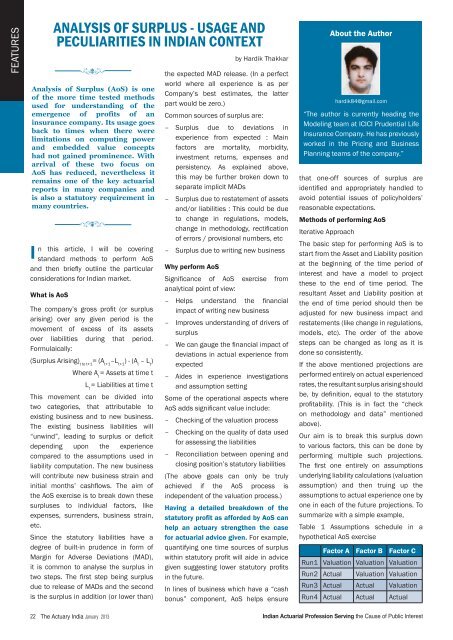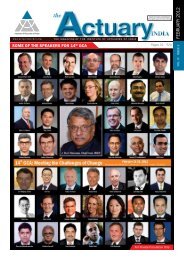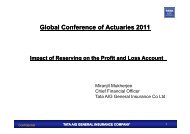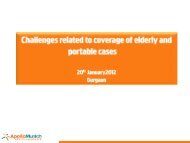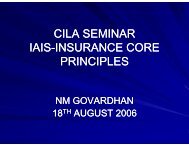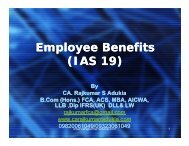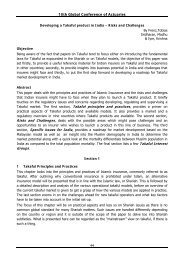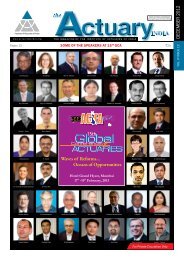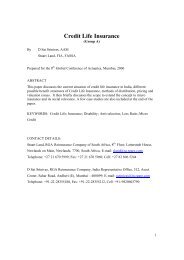January - Actuarial Society of India
January - Actuarial Society of India
January - Actuarial Society of India
You also want an ePaper? Increase the reach of your titles
YUMPU automatically turns print PDFs into web optimized ePapers that Google loves.
FEATURES<br />
I<br />
ANALYSIS OF SURPLUS - USAGE AND<br />
PEULIARITIES IN INDIAN ONTET<br />
Analysis <strong>of</strong> Surplus (AoS) is one<br />
<strong>of</strong> the more time tested methods<br />
used for understanding <strong>of</strong> the<br />
emergence <strong>of</strong> pr<strong>of</strong>its <strong>of</strong> an<br />
insurance company. Its usage goes<br />
back to times when there were<br />
limitations on computing power<br />
and embedded value concepts<br />
had not gained prominence. With<br />
arrival <strong>of</strong> these two focus on<br />
AoS has reduced, nevertheless it<br />
remains one <strong>of</strong> the key actuarial<br />
reports in many companies and<br />
is also a statutory requirement in<br />
many countries.<br />
n this article, I will be covering<br />
standard methods to perform AoS<br />
and then briey outline the particular<br />
considerations for <strong>India</strong>n market.<br />
What is AoS<br />
The company’s gross prot (or surplus<br />
arising over any given period is the<br />
movement <strong>of</strong> excess <strong>of</strong> its assets<br />
over liabilities during that period.<br />
Formulaically:<br />
(Surplus Arising t to t1<br />
(A t1<br />
–L t1<br />
- (A t<br />
– L t<br />
<br />
Where A t<br />
Assets at time t<br />
L t<br />
Liabilities at time t<br />
This movement can be divided into<br />
two categories, that attributable to<br />
existing business and to new business.<br />
The existing business liabilities will<br />
“unwind, leading to surplus or decit<br />
depending upon the experience<br />
compared to the assumptions used in<br />
liability computation. The new business<br />
will contribute new business strain and<br />
initial months’ cashows. The aim <strong>of</strong><br />
the AoS exercise is to break down these<br />
surpluses to individual factors, like<br />
expenses, surrenders, business strain,<br />
etc.<br />
Since the statutory liabilities have a<br />
degree <strong>of</strong> built-in prudence in form <strong>of</strong><br />
argin for Adverse eviations (A,<br />
it is common to analyse the surplus in<br />
two steps. The rst step being surplus<br />
due to release <strong>of</strong> As and the second<br />
is the surplus in addition (or lower than<br />
by Hardik Thakkar<br />
the expected A release. (In a perfect<br />
world where all experience is as per<br />
Company’s best estimates, the latter<br />
part would be zero.<br />
Common sources <strong>of</strong> surplus are:<br />
– Surplus due to deviations in<br />
experience from expected : ain<br />
factors are mortality, morbidity,<br />
investment returns, expenses and<br />
persistency. As explained above,<br />
this may be further broken down to<br />
separate implicit As<br />
– Surplus due to restatement <strong>of</strong> assets<br />
and/or liabilities : This could be due<br />
to change in regulations, models,<br />
change in methodology, rectication<br />
<strong>of</strong> errors / provisional numbers, etc<br />
– Surplus due to writing new business<br />
Why perform AoS<br />
Signicance <strong>of</strong> AoS exercise from<br />
analytical point <strong>of</strong> view:<br />
– Helps understand the nancial<br />
impact <strong>of</strong> writing new business<br />
– Improves understanding <strong>of</strong> drivers <strong>of</strong><br />
surplus<br />
– We can gauge the nancial impact <strong>of</strong><br />
deviations in actual experience from<br />
expected<br />
– Aides in experience investigations<br />
and assumption setting<br />
Some <strong>of</strong> the operational aspects where<br />
AoS adds signicant value include:<br />
– Checking <strong>of</strong> the valuation process<br />
– Checking on the quality <strong>of</strong> data used<br />
for assessing the liabilities<br />
– Reconciliation between opening and<br />
closing position’s statutory liabilities<br />
(The above goals can only be truly<br />
achieved if the AoS process is<br />
independent <strong>of</strong> the valuation process.<br />
Having a detailed breakdown <strong>of</strong> the<br />
statutory prot as afforded by AoS can<br />
help an actuary strengthen the case<br />
for actuarial advice given. For example,<br />
quantifying one time sources <strong>of</strong> surplus<br />
within statutory prot will aide in advice<br />
given suggesting lower statutory prots<br />
in the future.<br />
In lines <strong>of</strong> business which have a “cash<br />
bonus component, AoS helps ensure<br />
About the Author<br />
hardik4gmail.com<br />
“The author is currently heading the<br />
odeling team at ICICI Prudential Life<br />
Insurance Company. He has previously<br />
worked in the Pricing and Business<br />
Planning teams <strong>of</strong> the company.<br />
that one-<strong>of</strong>f sources <strong>of</strong> surplus are<br />
identied and appropriately handled to<br />
avoid potential issues <strong>of</strong> policyholders’<br />
reasonable expectations.<br />
Methods <strong>of</strong> performing AoS<br />
Iterative Approach<br />
The basic step for performing AoS is to<br />
start from the Asset and Liability position<br />
at the beginning <strong>of</strong> the time period <strong>of</strong><br />
interest and have a model to project<br />
these to the end <strong>of</strong> time period. The<br />
resultant Asset and Liability position at<br />
the end <strong>of</strong> time period should then be<br />
adjusted for new business impact and<br />
restatements (like change in regulations,<br />
models, etc. The order <strong>of</strong> the above<br />
steps can be changed as long as it is<br />
done so consistently.<br />
If the above mentioned projections are<br />
performed entirely on actual experienced<br />
rates, the resultant surplus arising should<br />
be, by denition, equal to the statutory<br />
protability. (This is in fact the “check<br />
on methodology and data mentioned<br />
above.<br />
Our aim is to break this surplus down<br />
to various factors, this can be done by<br />
performing multiple such projections.<br />
The rst one entirely on assumptions<br />
underlying liability calculations (valuation<br />
assumption and then truing up the<br />
assumptions to actual experience one by<br />
one in each <strong>of</strong> the future projections. To<br />
summarize with a simple example,<br />
Table 1 Assumptions schedule in a<br />
hypothetical AoS exercise<br />
Factor A Factor B Factor C<br />
Run1 Valuation Valuation Valuation<br />
Run2 Actual Valuation Valuation<br />
Run3 Actual Actual Valuation<br />
Run4 Actual Actual Actual<br />
22 The Actuary <strong>India</strong>


